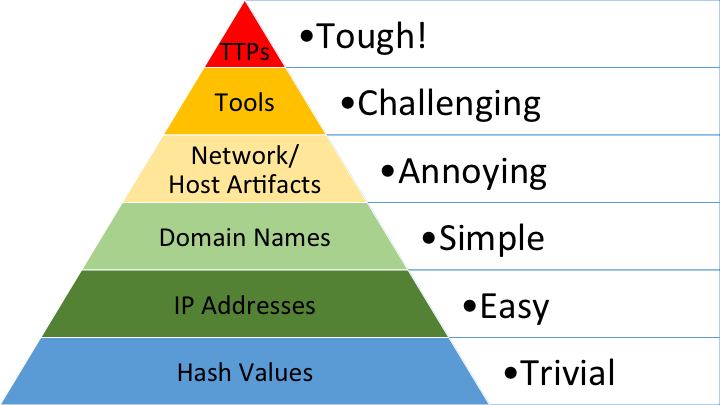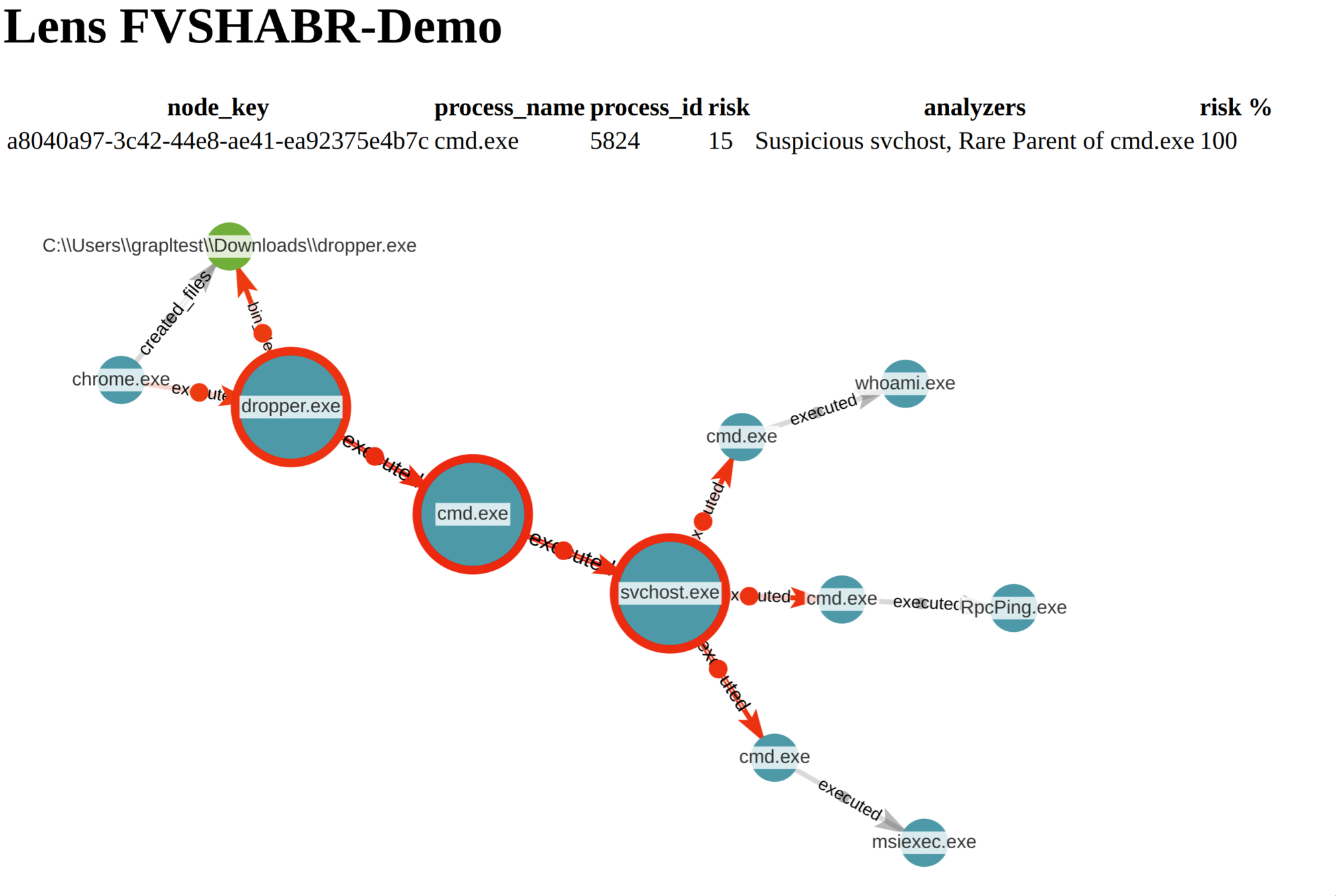GRAPL
WHY DO WE NEED A
NEW APPROACH TO A SIEM?
Log data is extremely "raw" & very disconnected.
An event may reference something opaque, like a "pid" or "uid", leaving it to the consumer to resolve what the entity behind it is.
Most SIEMs are built on databases that do a horrible job of performing JOIN operations - time series or streaming databases. JOIN is the most important operation!
The query languages are often bespoke and optimize for short queries, but attacker behaviors are becoming more complex than they can handle.
Security Engineers are being told to solve operations and data science problems when they should be focusing on security
PYRAMID OF PAIN

WE WANT
TO BE HERE!
AT BEST,
WE'RE HERE
MOST ARE HERE
This is not
how we climb
the pyramid of pain:
image_name="procdump"
args = "*-ma*"
args = "*lsass.exe*"[
{
'ppid': 100,
'pid': 250,
'action': 'started',
'time': '2019-02-24 18:21:25'
},
{
'ppid': 250,
'pid': 350,
'action': 'started',
'time': '2019-02-24 18:22:31'
}
][
{
'pid': 350,
'action': 'connected_to',
'domain': 'evil.com',
'time': '2019-02-24 18:24:27'
},
{
'pid': 350,
'action': 'created_file',
'path': 'downloads/evil.exe',
'time': '2019-02-24 18:28:31'
}
]seen_at: '2019-02-24 18:21:25'
created_at: '2019-02-24 18:21:25'
created_at: '2019-02-24 18:22:31'
seen_at: '2019-02-24 18:24:27'
seen_at: '2019-02-24 18:28:31'
seen_at: '2019-02-24 18:22:31'
seen_at: '2019-02-24 18:24:27'
seen_at: '2019-02-24 18:28:31'
What is Grapl?
Technically a SIEM
Platform focused -
"build a solution on Grapl"
Exposes data as a graph, not logs
Query Language in Python -
not another made up query language
Performs data cleaning upfront
Graph Platform
Platform Focus
Grapl is built on cloud services.
The idea is that if Grapl doesn't have a feature, someone can build one.
AWS gives us tons of primitives to do that.
Every service in Grapl is event-based, which is inherently extendable.
Grapl provides a Plugin interface, which lets you extend the system in a well defined way.
Graph Based
Graphs are an extremely general data structure, we can model anything as a graph, given the right instrumentation.
Attacker behaviors generally span a number of different entities and events.
Joining data together is critical to understanding the attacker.
"Defenders think in lists. Attackers think in graphs.
As long as this is true, attackers win."
{
"host_id": "cobrien-mac",
"parent_pid": 3,
"pid": 4,
"image_name": "word.exe",
"create_time": 600,
}
{
"host_id": "cobrien-mac",
"parent_pid": 4,
"pid": 5,
"image_name": "payload.exe",
"create_time": 650,
}explorer.exe
payload.exe
word.exe
word.exe
payload.exe
word.exe
word.exe
payload.exe
ssh.exe
/secret/file
11.22.34.55
mal.doc
PARSING
SUBGRAPH
GENERATION
IDENTIFICATION
MERGING
ANALYSIS
ENGAGEMENTS
Dropper:
- Dropper executes
- Dropper reaches out to network
- Dropper creates file
- Dropper executes file
A process that downloads
a payload & executes it.
// Search all processes over 1 hour for dropper-like behavior
search process_executions
| join [
| search process_executions process_id = $parent_process_id$
]
| join [
| search network_connections process_id = $parent_process_id$
]
| join [
| search file_creations creator=$parent_process_id$
AND $file_path$ = image_name
]
// TODO: Handle pid collisions"By default, subsearches return a maximum of 10,000 results and have a
maximum runtime of 60 seconds. In large production environments,
it is possible that subsearches [..] will timeout"
"Performing full SQL-style joins in a distributed system like
Elasticsearch is prohibitively expensive." [..]
"If you care about query performance, do not use this query."
class DropperAnalyzer(Analyzer):
def get_queries(self) -> OneOrMany[ProcessQuery]:
return (
ProcessQuery().with_bin_file()
.with_parent(
ProcessQuery()
.with_external_connections()
.with_created_files()
)
)
def on_response(self, payload: ProcessView, output: Sender):
dropper = payload.get_parent()
if payload.bin_file.get_file_path() in dropper.get_created_files():
output.send(
ExecutionHit(
analyzer_name="Dropper",
node_view=payload,
risk_score=75,
)
)
<any process>
<any file>
<external ip>
Process with external network access creates file, executes child from it
<any browser>
Browser Executing Child Process
<any process>
<winrar/7zip/zip>
<any file>
Process Executed From Unpacked Binary
<any process>
created file
executed as
Mitre ATT&CK | T1204 - User Execution
<any process>
Rare Parent Child Process
<any process>
executed
executed
created file
executed as
connected to
executed
<any process>
Rare Parent LOLBAS Process
<any process>
executed
<binary>
<lolbas path>
<word/reader/etc>
Commonly Target Application with Non-Whitelisted Child Process
<non whitelisted process>
executed
<any process>
svc_parent = svchost.get_parent()


Grapl + AWS
ec2 instance
role
ec2 instance
assumed role with IP
assumed role with IP
assumed role with IP
If we see a call with a sourceIPAddress that doesn’t match the previously observed IP, then we have detected a credential being used on an instance other than the one to which it was assigned, and we can assume that credential has been compromised.
NETFLIX CLOUD SECURITY:
Detecting Credential Compromise in AWS
class AwsCredentialReuse(Analyzer):
def get_queries(self) -> OneOrMany[Queryable]:
return (
AwsRoleQuery()
.with_assuming_ec2(
Ec2RoleAssumptionQuery()
.with_ip_address()
)
)
def on_response(self, role: AwsRoleView, output: Any):
unique_ips = set()
for role_assumption in role.assuming_ec2:
for ip in role_assumption.ip_address:
unique_ips.add(ip)
if len(unique_ips) > 1:
output.send(
ExecutionHit(
analyzer_name="AwsCredentialReuse",
node_view=role,
risk_score=100,
lenses=[role.arn, role.account]
)
)